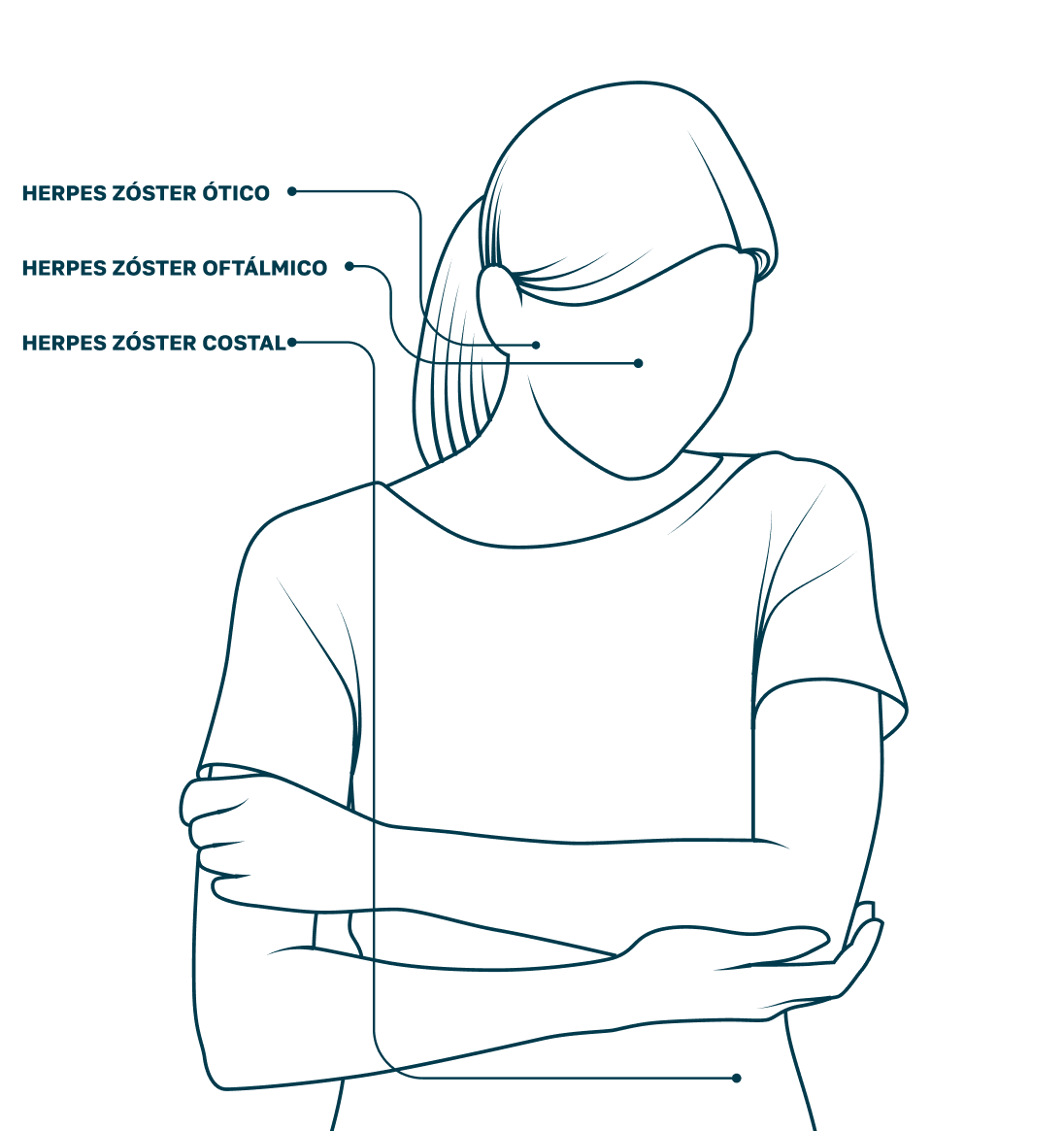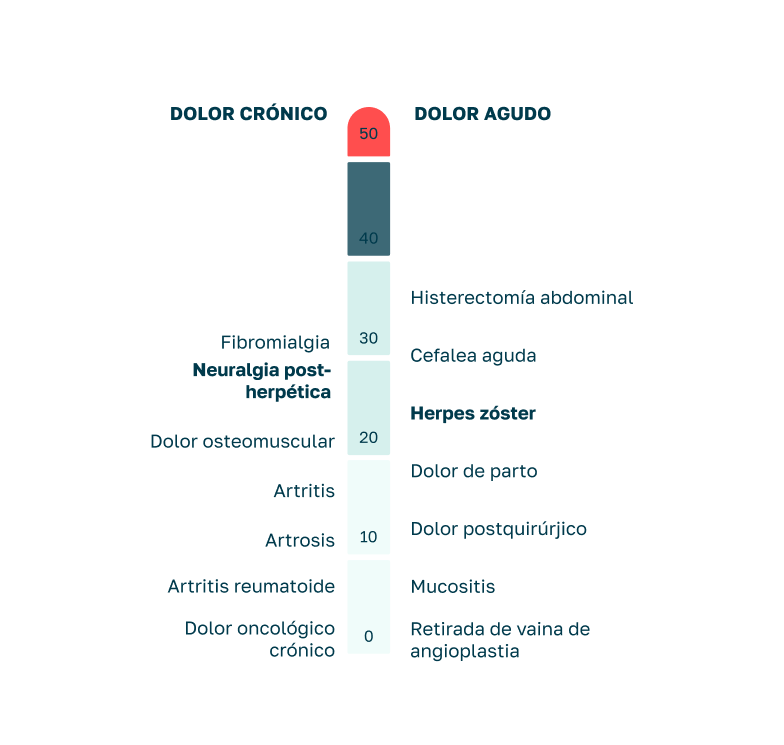Protect yourself from Herpes Zoster with Mivi
Shingles pain, also known as postherpetic neuralgia, is a painful condition that may persist after the disappearance of the skin lesions caused by shingles.
Anyone who has had chickenpox can develop Shingles, regardless of age. However, as we age, the cells of the immune system weaken, increasing the risk of contracting the disease.
It is estimated that 1 in 3 people between the ages of 50 and 90 will develop Herpes Zoster in their lifetime, and that the risk of developing the disease increases significantly after the age of 50.
👉🏻 Get vaccinated against Herpes Zoster
Symptoms
Generally the first symptoms of Herpes Zoster are itching, pain, tingling, uncomfortable sensation or tenderness to touch, usually on the chest or face. After the first few days, the acute phase of the disease begins, in which the rash appears, with blisters in the affected areas, accompanied by a stabbing pain. After about 10 days, the vesicles turn into scabs which usually last 2 to 4 weeks.
Prevention
There is a vaccine indicated for the prevention of Herpes Zoster and its main complication, Postherpetic Neuralgia, in:
- Immunocompetent adults over 50 years of age.
- Adults over 18 years of age in immunocompromised situation.
.
.
Treatment
Antiviral drugs are available to treat Shingles. These drugs help reduce the duration and severity of the disease, but to achieve their effectiveness, it is crucial to start treatment as soon as possible after the onset of the rash. Analgesics can provide pain relief, while recommended moist compresses and creams can help soothe itching. People experiencing symptoms of Herpes Zoster or suspecting its presence should consult their physician as soon as possible.
Types of Neuropathic Shingles Pain

Ardent
Many people describe the pain as a burning sensation.

Pungent
The pain may be sharp and stabbing.

Hypersensitivity
The skin can become extremely sensitive to touch, even rubbing against clothing can be painful.
Duration and scale of pain
Location
COSTAL HERPES ZOSTER (Costal area): representing approximately half of the cases, Herpes Zoster is frequently located in the costal area. Its main characteristics include the appearance of a burning pain of variable intensity. After a few days, small grouped blisters form on the skin and take on a characteristic girdle, belt or shingles-like shape, generally confined to one side of the body.
HERPES ZOSTER OTICOUS (lateral area of the face): Herpes Zoster, when it affects the facial nerve near one of the ears, is known as Ramsay Hunt syndrome. Its main features include pain of varying intensity and, after a few days, the appearance of small blisters clustered around the ear or inside the ear, usually on only one side of the face. It may also cause hearing loss or distortion, which may be temporary or permanent, as well as a sensation of vertigo.
HERPES ZOSTER OFTHALMICUS (Eye area): Herpes Zoster can affect the ophthalmic nerves, manifesting in the ocular area. Between 50% and 85% of cases result in conjunctivitis or retinitis. In some cases, vision may be compromised, causing visual loss ranging from mild to irreversible due to retinal involvement. This type of Herpes Zoster represents between 10% and 20% of the cases of the disease.
HERPES ZOSTER SINE-HERPETER: Herpes Zoster sine-herpete occurs when the varicella-zoster virus reactivates without causing the characteristic skin rash. Instead, it manifests only as diffuse neuropathic pain of unknown origin. This type of Herpes Zoster is very rare and therefore difficult to diagnose. Because of its rarity, it is often not treated early, which can result in a longer duration of symptoms and an increased occurrence of complications.

What are the possible complications?
Although most people recover completely, some may experience major complications. The most common complication is postherpetic neuralgia (PHN), a nerve pain that continues after the rash has healed. PHN can last from three to six months, and even persist longer. It is more common and severe in older people than in younger people. After age 50, up to 30% of patients with Shingles will develop Postherpetic Neuralgia.
OTHER COMPLICATIONS
What you need to know about Shingles Zoster

Not contagious
It is not transmitted from one person to another. To prevent the spread of V aricella-Zoster Virus (VZV), it is advisable to keep the rash covered and avoid direct contact with immune-compromised people, pregnant women and premature infants who have never had chickenpox or who are not vaccinated against it.

Its evolution
The acute phase of Herpes Zoster lasts between 2 and 4 weeks. Although this disease has a low mortality rate, it can lead to complications, the most common being Postherpetic Neuralgia.

Low mortality
Shingles has a low mortality rate, but its complications, particularly Postherpetic Neuralgia, can cause disability and affect the quality of life of those affected. The resulting pain can interfere with sleep, mood, work and daily activities, which has a negative impact on quality of life and can lead to social isolation and depression.
Can be preventedShingles and Postherpetic Neuralgia can be prevented by vaccination.
If you are over 50 or over 18 and have a depressed immune system, you can get vaccinated and avoid the disease. Ask us about prevention options and we will advise you.
Shingles and Postherpetic Neuralgia can be prevented by vaccination.
If you are over 50 or over 18 and have a depressed immune system, you can get vaccinated and avoid the disease. Ask us about prevention options and we will advise you.
Our customers say
Insurance companies
Ask your MIVI centre for information on the agreements with insurance companies.













